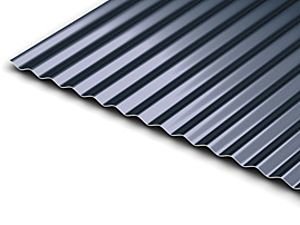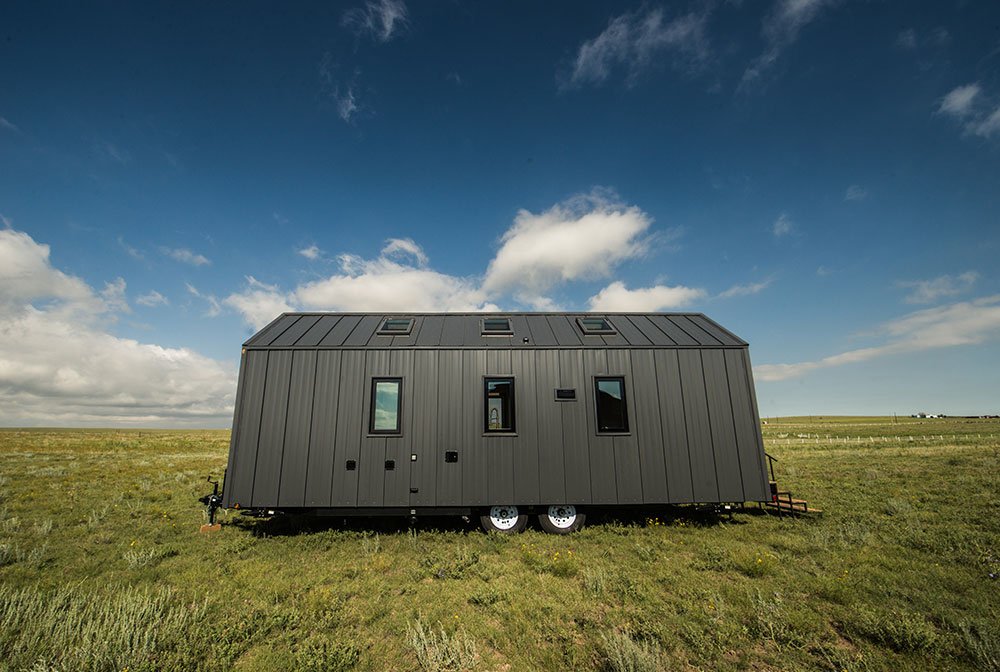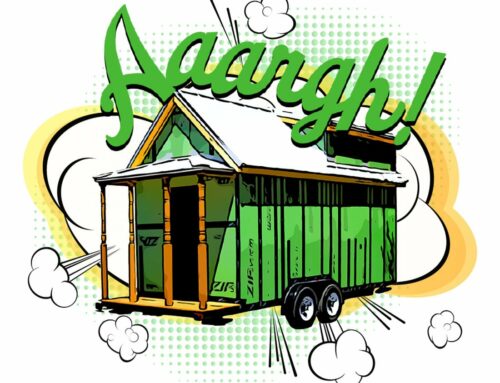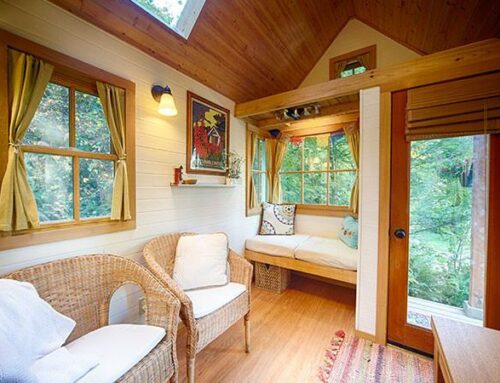I did a lot of research when I started thinking about my first tiny house roof. Immediately I could see it would be one of my bigger expenses and a huge influence on the ultimate aesthetic of the house. Conventional affordable roofing options like asphalt shingles offered no advantages in appearance, durability, or wind resistance (for towing). It was clear that metal was the best option in meeting each of these priorities.
 Metal panels are measured in gauges, and just like wire, the lower the gauge number, the thicker the metal. Galvanized corrugated 29 gauge steel roofing panels, like these at Cox Hardware and Lumber can be had for $7 or $8 per panel, but 26 gauge steelstanding seam panels from Metal Sales Manufacturing coated in CoolRoof colorfast paint keep the house cooler in summer, reduce the heat island effect, and are more leak resistant, weather proof, wind proof, long lasting, and – to me – attractive.
Metal panels are measured in gauges, and just like wire, the lower the gauge number, the thicker the metal. Galvanized corrugated 29 gauge steel roofing panels, like these at Cox Hardware and Lumber can be had for $7 or $8 per panel, but 26 gauge steelstanding seam panels from Metal Sales Manufacturing coated in CoolRoof colorfast paint keep the house cooler in summer, reduce the heat island effect, and are more leak resistant, weather proof, wind proof, long lasting, and – to me – attractive.There was a lot of information to digest. On the technical spectrum, I delved into coatings and their properties and how they can be engineered to offer better solar reflectance and heat emissivity. I learned a lot about the cool roof concept at the Energy Star Cool Roofs and Emissivity page.
 I also read up on installation issues like oilcanning, explained here by Sheffield Metals International. Apparently the roof panels get torqued slightly as they’re installed or as they shift with wood shrinkage and swelling, causing a wavy appearance to the sheets. Oilcanning can come from manufacturing stresses or installation stresses like carrying panels unevenly so they bend and ripple, or overtightening fasteners so they strain and warp the panels. It also arises from inevitable physical realities; roof support structures are typically made by hand of wood and it’s not possible for all their surfaces to be 100% perfectly straight, level, and uniform. There are ways to reduce oilcanning, but because it’s caused by several factors, it’s almost always present to some degree under certain conditions in any metal roof. The metal reps don’t admit this, but from experience I can tell you that the roof components themselves have a measurable (and sometimes significant) amount of variance in their dimensions as well. Then there’s the wide variety of angles at which the sunlight and our sight lines can hit the metal, and the inevitable expansion and contraction in any material under extreme temperatures and weather conditions. All told, it’s impossible to install a metal roof with any flat surfaces in such a way that it will never have the tension on the fasteners that leads to oilcanning.
I also read up on installation issues like oilcanning, explained here by Sheffield Metals International. Apparently the roof panels get torqued slightly as they’re installed or as they shift with wood shrinkage and swelling, causing a wavy appearance to the sheets. Oilcanning can come from manufacturing stresses or installation stresses like carrying panels unevenly so they bend and ripple, or overtightening fasteners so they strain and warp the panels. It also arises from inevitable physical realities; roof support structures are typically made by hand of wood and it’s not possible for all their surfaces to be 100% perfectly straight, level, and uniform. There are ways to reduce oilcanning, but because it’s caused by several factors, it’s almost always present to some degree under certain conditions in any metal roof. The metal reps don’t admit this, but from experience I can tell you that the roof components themselves have a measurable (and sometimes significant) amount of variance in their dimensions as well. Then there’s the wide variety of angles at which the sunlight and our sight lines can hit the metal, and the inevitable expansion and contraction in any material under extreme temperatures and weather conditions. All told, it’s impossible to install a metal roof with any flat surfaces in such a way that it will never have the tension on the fasteners that leads to oilcanning.Blog entries, like this one from the Building Gypsy Rose Blog, offered me an experiential view of what it was like to be a metal roof consumer, and it seemed there were a lot of cautionary tales out there. Every roof story I read came from a screwball construction comedy; wrong parts being delivered, wrong angles or dimensions, metal being delivered in the wrong amounts, parts being delivered damaged, and promised delivery dates being exceeded beyond all reason. Therefore I was very cautious about where I would order my roof.
When I looked into sourcing the roof panels, I found out metal roof panels are generally produced on computerized rolling machines and all the companies offered a similar range of products. Differentiation between options is about selecting gauge, seam type, fastener preference, panel texture, and coating properties, then picking an equivalent product from the nearest reliable reseller. In my case, there are only a couple manufacturers close enough to be practical, and each of them supply the same product line to all the different stores all over town. After talking with about every reseller in the area – Home Depot, Lowe’s, Friedman’s, and Meade Clark – I settled on Metal Sales 12″ wide 26 gauge standing seam panels from Allied Building Products. All the quotes I got were expensive, but Allied’s price matched the lowest of them, and they were a specialist with an office where I could see the product on their demos roofs outside and then place my order at a desk with an experienced pro who knew the product line inside and out.
The process was a little complicated and it took about a half hour to place my order. I brought an experienced builder with me because he’s installed metal roofing before, he would be installing this roof, and he has a much better knack for remembering measurements and specs than I do. Although he and I had both tried to anticipate and research all the decisions involved, we still ran into choices we hadn’t thought about and information we didn’t have. For example, I originally picked a flat panel option for the expanses of metal between each standing seam. Later, in discussion with our sales guy John, I discovered that the lightly striated panel reduces the visibility of any potential oil canning. Functionality won out over my slight aesthetic preference for the “cleaner” looking flat panels, and I was convinced to choose striations. In the end the metal roofing order (including panels, edge and peak trim, and specialized fasteners) cost about $1200 and I spent another $200 on sealant, adhesive, and high temperature gooey underlayment film called StormGuard by GAF.
I’m glad I did all that research, because I feel confident that in the end all our care has resulted in a roof that will keep the house safe cool and comfortable, maintain a beautiful look for 50 years, remain weatherproof for 100 years, and can be easily recycled at the end of its lifespan.








Leave A Comment